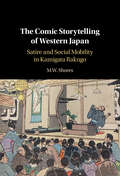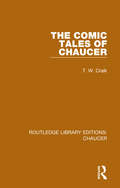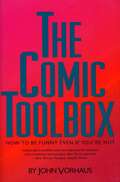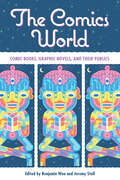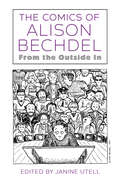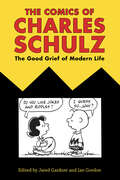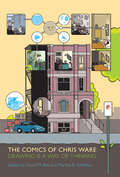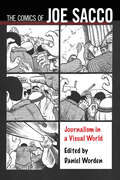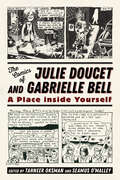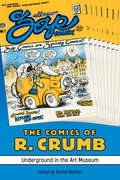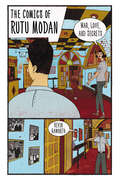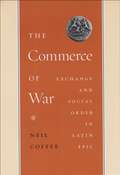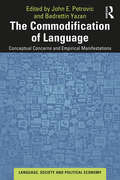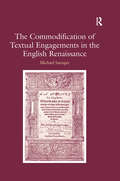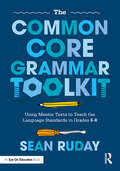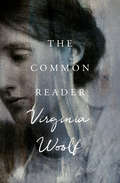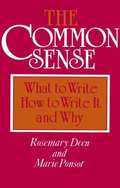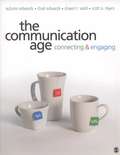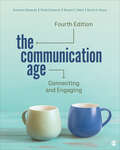- Table View
- List View
The Comic Self: Toward Dispossession (Thinking Theory)
by Grant Farred Timothy C. CampbellA provocative and unconventional call to dispossess the self of itself Challenging the contemporary notion of &“self-care&” and the Western mania for &“self-possession,&” The Comic Self deploys philosophical discourse and literary expression to propose an alternate and less toxic model for human aspiration: a comic self. Timothy Campbell and Grant Farred argue that the problem with the &“care of the self,&” from Foucault onward, is that it reinforces identity, strengthening the relation between I and mine. This assertion of self-possession raises a question vital for understanding how we are to live with each other and ourselves: How can you care for something that is truly not yours?The answer lies in the unrepresentable comic self. Campbell and Farred range across philosophy, literature, and contemporary comedy—engaging with Socrates, Burke, Hume, Hegel, Marx, Nietzsche, Heidegger, Derrida, Deleuze, and Levinas; Shakespeare, Cervantes, Woolf, Kafka, and Pasolini; and Stephen Colbert, David Chappelle, and the cast of Saturday Night Live. They uncover spaces where the dispossession of self and, with it, the dismantling of the regime of self-care are possible. Arguing that the comic self always keeps a precarious closeness to the tragic self, while opposing the machinations of capital endemic to the logic of self-possession, they provide a powerful and provocative antidote to the tragic self that so dominates the tenor of our times.
The Comic Storytelling of Western Japan: Satire and Social Mobility in Kamigata Rakugo
by M. W. ShoresRakugo, a popular form of comic storytelling, has played a major role in Japanese culture and society. Developed during the Edo (1600–1868) and Meiji (1868–1912) periods, it is still popular today, with many contemporary Japanese comedians having originally trained as rakugo artists. Rakugo is divided into two distinct strands, the Tokyo tradition and the Osaka tradition, with the latter having previously been largely overlooked. This pioneering study of the Kamigata (Osaka) rakugo tradition presents the first complete English translation of five classic rakugo stories, and offers a history of comic storytelling in Kamigata (modern Kansai, Kinki) from the seventeenth century to the present day. Considering the art in terms of gender, literature, performance, and society, this volume grounds Kamigata rakugo in its distinct cultural context and sheds light on the 'other' rakugo for students and scholars of Japanese culture and history.
The Comic Tales of Chaucer (Routledge Library Editions: Chaucer)
by T. W. CraikOriginally published in 1964. This book deals wholly with Chaucer’s comic tales. The individual tales are not discussed in isolation but always with reference to the others and to Chaucer’s poetry as a whole. By this comparison and analysis, this book illuminates the features of Chaucer’s many-sided art.
The Comic Toolbox: How To Be Funny Even If You're Not
by John VorhausA workbook approach to comedy writing as creative problem-solving. It offers tools of the trade such as Clash of Context, Tension and Release, The Law of Comic Opposites, The Wildly Inappropriate Response, and The Myth of the Last Great Idea to writers, comics, and anyone else who wants to be funny.
The Comics World: Comic Books, Graphic Novels, and Their Publics
by Benjamin Woo and Jeremy StollContributions by Bart Beaty, T. Keith Edmunds, Eike Exner, Christopher J. Galdieri, Ivan Lima Gomes, Charles Hatfield, Franny Howes, John A. Lent, Amy Louise Maynard, Shari Sabeti, Rob Salkowitz, Kalervo A. Sinervo, Jeremy Stoll, Valerie Wieskamp, Adriana Estrada Wilson, and Benjamin Woo The Comics World: Comic Books, Graphic Novels, and Their Publics is the first collection to explicitly examine the production, circulation, and reception of comics from a social-scientific point of view. Designed to promote interdisciplinary dialogue about theory and methods in comics studies, this volume draws on approaches from fields as diverse as sociology, political science, history, folklore, communication studies, and business, among others, to study the social life of comics and graphic novels. Taking the concept of a “comics world”—that is, the collection of people, roles, and institutions that “produce” comics as they are—as its organizing principle, the book asks readers to attend to the contexts that shape how comics move through societies and cultures. Each chapter explores a specific comics world or particular site where comics meet one of their publics, such as artists and creators; adaptors; critics and journalists; convention-goers; scanners; fans; and comics scholars themselves. Through their research, contributors demonstrate some of the ways that people participate in comics worlds and how the relationships created in these spaces can provide different perspectives on comics and comics studies. Moving beyond the page, The Comics World explores the complexity of the lived reality of the comics world: how comics and graphic novels matter to different people at different times, within a social space shared with others.
The Comics of Alison Bechdel: From the Outside In (Critical Approaches to Comics Artists Series)
by Janine UtellContributions by Michelle Ann Abate, Leah Anderst, Alissa S. Bourbonnais, Tyler Bradway, Natalja Chestopalova, Margaret Galvan, Judith Kegan Gardiner, Katie Hogan, Jonathan M. Hollister, Yetta Howard, Katherine Kelp-Stebbins, Don L. Latham, Vanessa Lauber, Katherine Parker-Hay, Anne N. Thalheimer, Janine Utell, and Susan R. Van Dyne Alison Bechdel is both a driver and beneficiary of the welcoming of comics into the mainstream. Indeed, the seemingly simple binary of outside/inside seems perpetually troubled throughout the career of this important comics artist, known for Fun Home, Are You My Mother?, and Dykes to Watch Out For. This volume extends the body of scholarship on her work from a range of interdisciplinary perspectives. In a definitive collection of original essays, scholars cover the span of Bechdel’s career, placing her groundbreaking early work within the context of her more well-known recent projects. The contributors provide new insights on major themes in Bechdel’s work, such as gender performativity, masculinity, lesbian politics and representation, trauma, life writing, and queer theory. Situating Bechdel among other comics artists, this book charts possible influences on her work, probes the experimental traits of her comics in their representations of kinship and trauma, combs archival materials to gain insight into Bechdel’s creative process, and analyzes her work in community building and space making through the comics form. Ultimately, the volume shows that Bechdel’s work consists of performing a series of selves—serializing the self, as it were—each constructed and refracted across and within her chosen artistic modes and genres.
The Comics of Charles Schulz: The Good Grief of Modern Life (Critical Approaches to Comics Artists Series)
by Jared Gardner and Ian GordonWith contributions by Leonie Brialey, MJ Clarke, Roy T. Cook, Joseph J. Darowski, Ian Gordon, Gene Kannenberg Jr., Christopher P. Lehman, Anne C. McCarthy, Ben Owen, Lara Saguisag, Ben Saunders, Jeffrey O. Segrave, and Michael TisserandThe Comics of Charles Schulz collects new essays on the work of the creator of the immensely popular Peanuts comic strip. Despite Schulz's celebrity, few scholarly books on his work and career have been published. This collection serves as a foundation for future study not only of Charles Schulz (1922-2000) but, more broadly, of the understudied medium of newspaper comics.Schulz's Peanuts ran for a half century, during which time he drew the strip and its characters to express keen observations on postwar American life and culture. As Peanuts' popularity grew, Schulz had opportunities to shape the iconography, style, and philosophy of modern life in ways he never could have imagined when he began the strip in 1950. Edited by leading scholars Jared Gardner and Ian Gordon, this volume ranges over a spectrum of Schulz's accomplishments and influence, touching on everything from cartoon aesthetics to the marketing of global fast food. Philosophy, ethics, and cultural history all come into play. Indeed, the book even highlights Snoopy's global reach as American soft power.As the broad interdisciplinary range of this volume makes clear, Peanuts offers countless possibilities for study and analysis. From many perspectives--including childhood studies, ethnic studies, health and exercise studies, as well as sociology--The Comics of Charles Schulz offers the most comprehensive and diverse study of the most influential cartoonist during the second half of the twentieth century.
The Comics of Chris Ware: Drawing Is a Way of Thinking
by David M. Ball Martha B. KuhlmanWith contributions by David M. Ball, Georgiana Banita, Margaret Fink Berman, Jacob Brogan, Isaac Cates, Joanna Davis-McElligatt, Shawn Gilmore, Matt Godbey, Jeet Heer, Martha B. Kuhlman, Katherine Roeder, Peter R. Sattler, Marc Singer, Benjamin Widiss, and Daniel WordenThe Comics of Chris Ware: Drawing Is a Way of Thinking brings together contributions from established and emerging scholars about the comics of Chicago-based cartoonist Chris Ware (b. 1967). Both inside and outside academic circles, Ware's work is rapidly being distinguished as essential to the developing canon of the graphic novel. Winner of the 2001 Guardian First Book Prize for the genre-defining Jimmy Corrigan: The Smartest Kid on Earth, Ware has received numerous accolades from both the literary and comics establishment. This collection addresses the range of Ware's work from his earliest drawings in the 1990s in The ACME Novelty Library and his acclaimed Jimmy Corrigan, to his most recent works-in-progress, “Building Stories” and “Rusty Brown.”
The Comics of Hergé: When the Lines Are Not So Clear (Critical Approaches to Comics Artists Series)
by Joe Sutliff SandersContributions by Jônathas Miranda de Araújo, Guillaume de Syon, Hugo Frey, Kenan Koçak, Andrei Molotiu, Annick Pellegrin, Benjamin Picado, Vanessa Meikle Schulman, Matthew Screech, and Gwen Athene Tarbox As the creator of Tintin, Hergé (1907–1983) remains one of the most important and influential figures in the history of comics. When Hergé, born Georges Prosper Remi in Belgium, emerged from the controversy surrounding his actions after World War II, his most famous work leapt to international fame and set the standard for European comics. While his style popularized what became known as the “clear line” in cartooning, this edited volume shows how his life and art turned out much more complicated than his method. The book opens with Hergé’s aesthetic techniques, including analyses of his efforts to comprehend and represent absence and the rhythm of mundaneness between panels of action. Broad views of his career describe how Hergé navigated changing ideas of air travel, while precise accounts of his life during Nazi occupation explain how the demands of the occupied press transformed his understanding of what a comics page could do. The next section considers a subject with which Hergé was himself consumed: the fraught lines between high and low art. By reading the late masterpieces of the Tintin series, these chapters situate his artistic legacy. A final section considers how the clear line style has been reinterpreted around the world, from contemporary Francophone writers to a Chinese American cartoonist and on to Turkey, where Tintin has been reinvented into something meaningful to an audience Hergé probably never anticipated. Despite the attention already devoted to Hergé, no multi-author critical treatment of his work exists in English, the majority of the scholarship being in French. With contributors from five continents drawing on a variety of critical methods, this volume’s range will shape the study of Hergé for many years to come.
The Comics of Joe Sacco: Journalism in a Visual World (Critical Approaches to Comics Artists Series)
by Daniel WordenNamed a Notable Scholarly Publication of 2015 by the Comics Studies SocietyContributions by Georgiana Banita, Lan Dong, Ann D'Orazio, Kevin C. Dunn, Alexander Dunst, Jared Gardner, Edward C. Holland, Isabel Macdonald, Brigid Maher, Ben Owen, Rebecca Scherr, Maureen Shay, Marc Singer, Richard Todd Stafford, and Øyvind VågnesThe Comics of Joe Sacco addresses the range of his award-winning work, from his early comics stories as well as his groundbreaking journalism Palestine (1993) and Safe Area to Goražde (2000), to Footnotes in Gaza (2009) and his most recent book The Great War (2013), a graphic history of World War I.First in the series, Critical Approaches to Comics Artists, this edited volume explores Sacco's comics journalism and features established and emerging scholars from comics studies, cultural studies, geography, literary studies, political science, and communication studies. Sacco's work has already found a place in some of the foundational scholarship in comics studies, and this book solidifies his role as one of the most important comics artists today.Sections focus on how Sacco's comics journalism critiques and employs the standard of objectivity in mainstream reporting, what aesthetic principles and approaches to lived experience can be found in his comics, how Sacco employs the space of the comics page to map history and war, and the ways that his comics function in the classroom and as human rights activism. The Comics of Joe Sacco offers definitive, exciting approaches to some of the most important--and necessary--comics today, by one of the most acclaimed journalist-artists of our time.
The Comics of Julie Doucet and Gabrielle Bell: A Place inside Yourself (Critical Approaches to Comics Artists Series)
by Tahneer Oksman and Seamus O’MalleyWinner of the 2020 Comics Studies Society Edited Book PrizeContributions by Kylie Cardell, Aaron Cometbus, Margaret Galvan, Sarah Hildebrand, Frederik Byrn Køhlert, Tahneer Oksman, Seamus O’Malley, Annie Mok, Dan Nadel, Natalie Pendergast, Sarah Richardson, Jessica Stark, and James Yeh In a self-reflexive way, Julie Doucet’s and Gabrielle Bell’s comics, though often autobiographical, defy easy categorization. In this volume, editors Tahneer Oksman and Seamus O’Malley regard Doucet’s and Bell’s art as actively feminist, not only because they offer women’s perspectives, but because they do so by provocatively bringing up the complicated, multivalent frameworks of such engagements. While each artist has a unique perspective, style, and worldview, the essays in this book investigate their shared investments in formal innovation and experimentation, and in playing with questions of the autobiographical, the fantastic, and the spaces in between. Doucet is a Canadian underground cartoonist, known for her autobiographical works such as Dirty Plotte and My New York Diary. Meanwhile, Bell is a British American cartoonist best known for her intensely introspective semiautobiographical comics and graphic memoirs, such as the Lucky series and Cecil and Jordan in New York. By pairing Doucet alongside Bell, the book recognizes the significance of female networks, and the social and cultural connections, associations, and conditions that shape every work of art. In addition to original essays, this volume republishes interviews with the artists. By reading Doucet’s and Bell’s comics together in this volume housed in a series devoted to single-creator studies, the book shows how, despite the importance of finding “a place inside yourself” to create, this space seems always for better or worse a shared space culled from and subject to surrounding lives, experiences, and subjectivities.
The Comics of R. Crumb: Underground in the Art Museum (Critical Approaches to Comics Artists Series)
by Daniel WordenContributions by José Alaniz, Ian Blechschmidt, Paul Fisher Davies, Zanne Domoney-Lyttle, David Huxley, Lynn Marie Kutch, Julian Lawrence, Liliana Milkova, Stiliana Milkova, Kim A. Munson, Jason S. Polley, Paul Sheehan, Clarence Burton Sheffield Jr., and Daniel Worden From his work on underground comix like Zap and Weirdo, to his cultural prominence, R. Crumb is one of the most renowned comics artists in the medium’s history. His work, beginning in the 1960s, ranges provocatively and controversially over major moments, tensions, and ideas in the late twentieth and early twenty-first centuries, from the counterculture and the emergence of the modern environmentalist movement, to racial politics and sexual liberation. While Crumb’s early work refined the parodic, over-the-top, and sexually explicit styles we associate with underground comix, he also pioneered the comics memoir, through his own autobiographical and confessional comics, as well as in his collaborations. More recently, Crumb has turned to long-form, book-length works, such as his acclaimed Book of Genesis and Kafka. Over the long arc of his career, Crumb has shaped the conventions of underground and alternative comics, autobiographical comics, and the “graphic novel.” And, through his involvement in music, animation, and documentary film projects, Crumb is a widely recognized persona, an artist who has defined the vocation of the cartoonist in a widely influential way. The Comics of R. Crumb: Underground in the Art Museum is a groundbreaking collection on the work of a pioneer of underground comix and a fixture of comics culture. Ranging from art history and literary studies, to environmental studies and religious history, the essays included in this volume cast Crumb's work as formally sophisticated and complex in its representations of gender, sexuality, race, politics, and history, while also charting Crumb’s role in underground comix and the ways in which his work has circulated in the art museum.
The Comics of Rutu Modan: War, Love, and Secrets (Great Comics Artists Series)
by Kevin HaworthBest known for her Eisner Award–winning graphic novels, Exit Wounds and The Property, Rutu Modan’s richly colored compositions invite readers into complex Israeli society, opening up a world too often defined only by news headlines. Her strong female protagonists stick out in a comics scene still too dominated by men, as she combines a mystery novelist’s plotting with a memoirist’s insights into psychology and trauma. The Comics of Rutu Modan: War, Love, and Secrets conducts a close reading of her work and examines her role in creating a comics arts scene in Israel. Drawing upon archival research, Kevin Haworth traces the history of Israeli comics from its beginning as 1930s cheap children’s stories, through the counterculture movement of the 1970s, to the burst of creativity that began in the 1990s and continues full force today. Based on new interviews with Modan (b. 1966) and other comics artists, Haworth indicates the key role of Actus Tragicus, the collective that changed Israeli comics forever and launched her career. Haworth shows how Modan’s work grew from experimental minicomics to critically acclaimed graphic novels, delving into the creative process behind Exit Wounds and The Property. He analyzes how the recurring themes of family secrets and absence weave through her stories and how she adapts the famous clear line illustration style to her morally complex tales. Though still relatively young, Modan has produced a remarkably varied oeuvre. Identifying influences from the United States and Europe, Haworth illustrates how Modan’s work is global in its appeal, even as it forms a core of the thriving Israeli cultural scene.
The Commerce of War: Exchange and Social Order in Latin Epic
by Neil CoffeeLatin epics such as Virgil’s Aeneid, Lucan’s Civil War, and Statius’s Thebaid addressed Roman aristocrats whose dealings in gifts, favors, and payments defined their conceptions of social order. In The Commerce of War, Neil Coffee argues that these exchanges play a central yet overlooked role in epic depictions of Roman society. Tracing the collapse of an aristocratic worldview across all three poems, Coffee highlights the distinction they draw between reciprocal gift giving among elites and the more problematic behaviors of buying and selling. In the Aeneid, customary gift and favor exchanges are undermined by characters who view human interaction as short-term and commodity-driven. The Civil War takes the next logical step, illuminating how Romans cope once commercial greed has supplanted traditional values. Concluding with the Thebaid, which focuses on the problems of excessive consumption rather than exchange, Coffee closes his powerful case that these poems constitute far-reaching critiques of Roman society during its transition from republic to empire.
The Commodification of Identity in Victorian Narrative: Autobiography, Sensation, and the Literary Marketplace (Cambridge Studies in Nineteenth-Century Literature and Culture #121)
by Sean GrassIn the first half of the nineteenth century autobiography became, for the first time, an explicitly commercial genre. Drawing together quantitative data on the Victorian book markets, insights from the business ledgers of Victorian publishers and close readings of mid-century novels, Sean Grass demonstrates the close links between these genres and broader Victorian textual and material cultures. This book offers fresh perspectives on major works by Charles Dickens, George Eliot, Mary Elizabeth Braddon, Wilkie Collins and Charles Reade, while also featuring archival research that reveals the volume, diversity, and marketability of Victorian autobiographical texts for the first time. Grass presents life-writing not as a stand-alone genre, but as an integral part of a broader movement of literary, cultural, legal and economic practices through which the Victorians transformed identity into a textual object of capitalist exchange.
The Commodification of Language: Conceptual Concerns and Empirical Manifestations (Language, Society and Political Economy)
by John E. PetrovicThis volume seeks to add to our understanding of how language is constructed in late capitalist societies. Exploring the conceptual and theoretical underpinnings of the so-called "commodification of language" and its relationship to the notion of linguistic capital, the authors examine recent research that offers implications for language policy and planning. Bringing together an international group of scholars, this collection includes chapters that address whether or not language can rightly be referred to as a commodity and, if so, under what circumstances. The different theoretical foundations of understanding language as a resource with exchange value – whether as commodity or capital – have practical implications for policy writ large. The implications of the "commodification of language" in more empirical terms are explored, both in terms of how it affects language as well as language policy at more micro levels. This includes more specific policy arenas such as language in education policy or family language policies as well as the implications for individual identity construction and linguistic communities. With a conclusion written by leading scholar David Block, this is key reading for researchers and advanced students of critical sociolinguistics, language and economy, language and politics, language policy and linguistic anthropology within linguistics, applied linguistics, and language teacher education.
The Commodification of Textual Engagements in the English Renaissance
by Michael SaengerAn investigation into the ways in which early modern books were advertised, this study argues that those means of advertisement both record and help to shape social interactions between people and books. These interactions are not only fascinating in themselves, but also demonstrably linked to larger social phenomena, such as human commodification, the development of English nationalism, the increasingly unruly proliferation of literacy, and changing conceptions of literature. Within the context of recent developments of new textualism and new economic criticism, Saenger's approach makes use of formalist strategies of genre recognition as well as new historicist connections between social history and art. In this study Saenger illustrates his general account of the formal properties of front matter-titles and subtitles, prefatory epistles, and commendatory verses-with engaging readings of specific examples, including Feltham's Resolves, A Myrrovre for Magistrates, and Sidney's Arcadia. He explores the several ways in which paratextual authors sought to involve the reader in various active roles vis à vis the main text, whether those books were prose fiction or translated continental sermons. Some particular attention is devoted to printed drama, both because dramatic texts present printers with a unique set of challenges and because those texts have often been misread in recent criticism. This book offers a much-needed analysis of profound transformations-not only to the book trade as an industry, but also to the very concepts of reading and authorship-in an age which saw the relatively brief coincidence of ancient marketing strategies and systems and the burgeoning market of the mechanically reproduced text.
The Common Core Grammar Toolkit: Using Mentor Texts to Teach the Language Standards in Grades 6-8
by Sean RudayThe Common Core’s language standards can seem overwhelming—students need to learn specific, complex grammar rules at each grade level. The Common Core Grammar Toolkit to the rescue! This comprehensive guide makes grammar instruction fun and meaningful. You will learn how to… • Teach the Common Core’s language standards for grades 6–8 by presenting each grammar rule as a useful writing tool.• Use mentor texts—excerpts from great literature—to help students understand grammar in action.• Promote metacognition along the way, so that students become responsible for their own learning. The book thoroughly covers how to teach the Common Core’s language standards for grades 6-8, on topics such as understanding intensive pronouns, using commas to set off nonrestrictive clauses, maintaining consistency in style and tone, forming verbs in different moods, and much, much more. You’ll learn how to present each of these grammar rules to your students as tools that will help them improve their writing. You’ll also find classroom snapshots that show the tools in action, and handy, reproducible charts that you can use with your own students. Bonus! The book includes a free annotated bibliography, which is offered as a Supplemental Download on our website. The bibliography lists high-quality young adult literature and gives examples of key grammatical concepts found in each work, so you can use additional mentor texts with your students.
The Common Growl: Toward a Poetics of Precarious Community (Commonalities)
by Thomas ClaviezNo longer able to read community in terms colored by a romantic nostalgia for homogeneity, closeness and sameness, or the myth of rational choice, we nevertheless face an imperative to think the common. The prominent scholars assembled here come together to articulate community while thinking seriously about the tropes, myths, narratives, metaphors, conceits, and shared cultural texts on which any such articulation depends. The result is a major contribution to literary theory, postcolonialism, philosophy, political theory, and sociology.
The Common Reader: First Series, Annotated Edition (The Common Reader #1)
by Virginia WoolfA collection of essays from the acclaimed author of Mrs. Dalloway on such subjects as Jane Austen, Geoffrey Chaucer, and her own literary philosophy. A good essay must have this permanent quality about it; it must draw its curtain round us, but it must be a curtain that shuts us in not out. Not written for scholars or critics, these essays are a collection of Virginia Woolf&’s everyday thoughts about literature and the world—and the art of reading for pleasure. That many of them previously appeared in such publications as the Nation, Vogue, and the Yale Review points to their widespread appeal. Still, her brilliant powers of observation and insatiable curiosity shine through . . . &“After all, Mrs. Woolf is no common reader, try as she may to be one. Her powers of coordination and logical inference are altogether too strong and capable. No common reader would kick the over-praised Robinson Crusoe overboard to float in seas of adolescent adoration for Moll Flanders, as she does. It would take an uncommon common reader to discourse as pithily on Elizabethan drama or the furiously literary Duchess of Newcastle. No idle peruser of the printed page would meditate so beautifully on Greek letters. And when we come to those essays, &‘Modern Fiction&’ and &‘How It Strikes a Contemporary,&’ a note that is altogether professional and the result of intensive study and theorizing is to be discerned.&” —The New York Times &“Woolf&’s provocative collection of essays, reviews and flights of literary imagination assesses both the famous and the obscure.&” —The Times (London)
The Common Sense: What to Write, How to Write It, and Why
by Marie Ponsot Rosemary DeenThis is a brief book teaching the elements of writing inductively, by organized experience; and concentrating the practice of writing on the expository essay, the essay which supports what it asserts. You can use the book for four kinds of expository writing courses. The most beautiful course, which underlies the others, is "Elements of the Essay." It suits inexperienced writers of all ages; or writers who want to practice all the elements of writing in a developing way; or mixed groups of writers. The second course, "Two-Part Essay Shapes", teaches the essay by beginning with classic forms. Both the third and fourth courses include analysis of outside texts.
The Communication Age: Connecting and Engaging
by Autumn Edwards Chad Edwards Shawn T. Wahl Scott A. MyersNo matter who you are or how you communicate―from baby boomers to millenials, born digital or getting there―we are all members of a society who connect through the internet, not just to it. From face-to-face to facebook, this book by Autumn Edwards, Chad Edwards, Shawn T. Wahl, and Scott A. Myers invites you to join the conversation about today's issues and have your voice heard.
The Communication Age: Connecting and Engaging
by Autumn Edwards Shawn T. Wahl Scott A. Myers Chad C. EdwardsWhen should you send a text message, and when is it more appropriate to talk face-to-face? What is the best way to prepare for a job interview that will be conducted over video? How should you modify your speech if it will be recorded and posted online? The Communication Age: Connecting and Engaging introduces students to the foundational concepts and essential skills of effective communication, with a strong emphasis on the impact of technology in our increasingly interconnected world. This new Fourth Edition helps students become involved in our diverse global community and learn how to apply key principles of effective communication—whether incorporating media, technology, or traditional face-to-face speech communication—to foster civic engagement for a better future. With comprehensive coverage of the essentials of interpersonal, small group, and public communication, this text is ideal for use in hybrid introduction to communication courses.
The Communication Age: Connecting and Engaging
by Autumn Edwards Shawn T. Wahl Scott A. Myers Chad C. EdwardsWhen should you send a text message, and when is it more appropriate to talk face-to-face? What is the best way to prepare for a job interview that will be conducted over video? How should you modify your speech if it will be recorded and posted online? The Communication Age: Connecting and Engaging introduces students to the foundational concepts and essential skills of effective communication, with a strong emphasis on the impact of technology in our increasingly interconnected world. This new Fourth Edition helps students become involved in our diverse global community and learn how to apply key principles of effective communication—whether incorporating media, technology, or traditional face-to-face speech communication—to foster civic engagement for a better future. With comprehensive coverage of the essentials of interpersonal, small group, and public communication, this text is ideal for use in hybrid introduction to communication courses.

